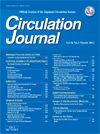Volume 67, Issue 3
Displaying 1-22 of 22 articles from this issue
- |<
- <
- 1
- >
- >|
Review Article
-
Article type: None
Subject area: None
2003 Volume 67 Issue 3 Pages 177-186
Published: 2003
Released on J-STAGE: February 25, 2003
Download PDF (561K)
Clinical Investigation
-
Article type: None
Subject area: None
2003 Volume 67 Issue 3 Pages 187-190
Published: 2003
Released on J-STAGE: February 25, 2003
Download PDF (187K) -
Article type: None
Subject area: None
2003 Volume 67 Issue 3 Pages 191-194
Published: 2003
Released on J-STAGE: February 25, 2003
Download PDF (89K) -
Article type: None
Subject area: None
2003 Volume 67 Issue 3 Pages 195-198
Published: 2003
Released on J-STAGE: February 25, 2003
Download PDF (127K) -
Article type: None
Subject area: None
2003 Volume 67 Issue 3 Pages 199-202
Published: 2003
Released on J-STAGE: February 25, 2003
Download PDF (135K) -
Article type: None
Subject area: None
2003 Volume 67 Issue 3 Pages 203-208
Published: 2003
Released on J-STAGE: February 25, 2003
Download PDF (121K) -
Article type: None
Subject area: None
2003 Volume 67 Issue 3 Pages 209-214
Published: 2003
Released on J-STAGE: February 25, 2003
Download PDF (290K) -
Article type: None
Subject area: None
2003 Volume 67 Issue 3 Pages 215-220
Published: 2003
Released on J-STAGE: February 25, 2003
Download PDF (100K) -
Article type: None
Subject area: None
2003 Volume 67 Issue 3 Pages 221-224
Published: 2003
Released on J-STAGE: February 25, 2003
Download PDF (234K) -
Article type: None
Subject area: None
2003 Volume 67 Issue 3 Pages 225-228
Published: 2003
Released on J-STAGE: February 25, 2003
Download PDF (128K) -
Article type: None
Subject area: None
2003 Volume 67 Issue 3 Pages 229-232
Published: 2003
Released on J-STAGE: February 25, 2003
Download PDF (116K) -
Article type: None
Subject area: None
2003 Volume 67 Issue 3 Pages 233-237
Published: 2003
Released on J-STAGE: February 25, 2003
Download PDF (114K) -
Article type: None
Subject area: None
2003 Volume 67 Issue 3 Pages 238-242
Published: 2003
Released on J-STAGE: February 25, 2003
Download PDF (61K) -
Article type: None
Subject area: None
2003 Volume 67 Issue 3 Pages 243-247
Published: 2003
Released on J-STAGE: February 25, 2003
Download PDF (163K)
Experimental Investigation
-
Article type: None
Subject area: None
2003 Volume 67 Issue 3 Pages 248-252
Published: 2003
Released on J-STAGE: February 25, 2003
Download PDF (307K) -
Article type: None
Subject area: None
2003 Volume 67 Issue 3 Pages 253-258
Published: 2003
Released on J-STAGE: February 25, 2003
Download PDF (253K) -
Article type: None
Subject area: None
2003 Volume 67 Issue 3 Pages 259-262
Published: 2003
Released on J-STAGE: February 25, 2003
Download PDF (200K) -
Article type: None
Subject area: None
2003 Volume 67 Issue 3 Pages 263-268
Published: 2003
Released on J-STAGE: February 25, 2003
Download PDF (389K)
Case Report
-
Article type: None
Subject area: None
2003 Volume 67 Issue 3 Pages 269-272
Published: 2003
Released on J-STAGE: February 25, 2003
Download PDF (277K) -
Article type: None
Subject area: None
2003 Volume 67 Issue 3 Pages 273-274
Published: 2003
Released on J-STAGE: February 25, 2003
Download PDF (106K) -
Article type: None
Subject area: None
2003 Volume 67 Issue 3 Pages 275-276
Published: 2003
Released on J-STAGE: February 25, 2003
Download PDF (308K) -
Article type: None
Subject area: None
2003 Volume 67 Issue 3 Pages 277-278
Published: 2003
Released on J-STAGE: February 25, 2003
Download PDF (415K)
- |<
- <
- 1
- >
- >|
